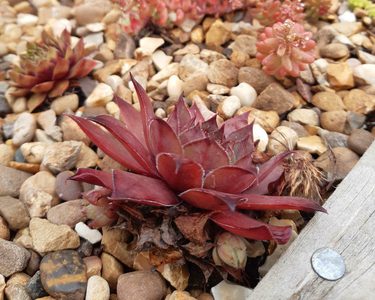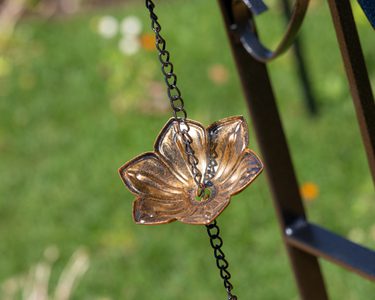Five take outs from our Backyard Biodiversity show garden

Our Backyard Biodiversity stand at Audley End is all about showing gardeners how to make their gardens better able to withstand the effects of climate change. We've compiled five key techniques you can use in your garden to increase wildlife, drought tolerance and reduce run-off.
1. Install a living roof
Our mini green roof of sempervivums, sedums and wild strawberries creates a real buzz. These flowering plants attract lots of insects, but they’re also able to withstand drought conditions, and a shallow substrate – making them a perfect way to rewild a shed roof, wheelie bin screen or bike shed. Greening hard surfaces like this is a good way to help your garden absorb more rainfall, reducing run-off and the chances of flooding.

2. Grow perennial vegetables
In our show garden, we demonstrate low-maintenance, resilient vegetables such as Egyptian walking onions, yacon, skirret and Turkish rocket. They help save money in the veg garden, because they come back each year, without the need for new seeds or plants. Find out more about growing perennial veg here.

3. Create a gravel garden
Many plants cope well with drier conditions, and a gravel garden is an attractive and low-maintenance way to display them. Try to use materials you already have to hand, but if you have to buy in - source gravel from local suppliers or look out for recycled products, such as eco-aggregates.
In our gravel garden, we've included drought tolerant verbena with its beautiful towering stems topped with purple flowers, aromatic lavender – which is great for bees – sedum and creeping thyme. All these plants have the added benefit of being brilliant for pollinators too. Click here for more information on gardening in drought.

4. Capture rainwater
Finding ways to collect water is key to an organic garden. A water butt is one of the best ways to save and reuse precious rainwater, but in our Backyard Biodiversity garden we've also demonstrated using Olla pots, which are buried into the ground. The terracotta pots allow water to seep gently into the soil near plants roots. Rain chains are another novel solution, which have been used for hundreds of years in Japanese gardens. They can be attached to a drainpipe (where the downpipe should be), to divert water to a thirsty plant or garden bed. You can also allow water to collect in a barrel or watering can and enjoy the tinkling sound like a water feature.

5. Let your lawn grow wild
Lawns that are full of high-pollen wild plants and weeds are much better for bringing biodiversity to your backyard. Instead of a monoculture of grass, we've dotted our Autumn Show garden lawn with clovers, daises and dandelions to demonstrate how fantastic these plants are for attracting pollinators. Lawns like this will also help mop up more run-off from stormwater.
